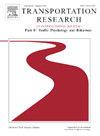High-speed curve negotiation: Can differences in expertise account for the different effects of cognitive load?
IF 3.5
2区 工程技术
Q1 PSYCHOLOGY, APPLIED
Transportation Research Part F-Traffic Psychology and Behaviour
Pub Date : 2024-11-01
DOI:10.1016/j.trf.2024.10.014
引用次数: 0
Abstract
The role of expertise in the relationship between cognitive load (CL) and driving performance has received little scientific attention. This real-world study included 8 expert race car drivers and 10 non-expert drivers, who were driving on a racetrack while simultaneously performing cognitively distracting secondary tasks. The experiment examined whether the effects of CL on high-speed driving performance of hairpin, compound, and reverse curves are influenced by drivers’ expertise. In general, we found that non-expert drivers were not any more vulnerable to CL-induced performance decrements than skilled expert drivers, although the relationship between driving expertise and CL appeared to be task- and curve type-dependent. While between-group differences in secondary task performance were not obtained, speed was found to decrease in CL conditions but only in sharp hairpin curves. Additionally, CL affected experts’ and non-experts’ lateral performance in all curve types, although a clear relationship between trajectory deviations and steering corrections was not obtained. While the effects of CL appear to be the most prominent in sharp hairpin curves, the findings of this study suggest curve geometry as a variable that needs greater attention in future studies.
高速曲线谈判:专业知识的差异能否解释认知负荷的不同影响?
专业知识在认知负荷(CL)和驾驶表现之间的关系中的作用很少受到科学界的关注。这项真实世界的研究包括 8 名专业赛车手和 10 名非专业赛车手,他们在赛道上驾驶的同时还要执行分散认知注意力的次要任务。实验研究了CL对发夹弯、复合弯和反向弯高速驾驶性能的影响是否受驾驶者专业知识的影响。总体而言,我们发现非专业驾驶者并不比熟练的专业驾驶者更容易受到CL导致的成绩下降的影响,尽管驾驶技术与CL之间的关系似乎取决于任务和弯道类型。虽然在次要任务表现方面没有发现组间差异,但我们发现在CL条件下速度会下降,但仅限于急转弯。此外,CL 对专家和非专家在所有弯道类型中的横向成绩都有影响,尽管轨迹偏差和转向修正之间没有明确的关系。虽然 CL 的影响似乎在急发夹弯道中最为突出,但本研究的结果表明,在未来的研究中,弯道几何是一个需要更多关注的变量。
本文章由计算机程序翻译,如有差异,请以英文原文为准。
求助全文
约1分钟内获得全文
求助全文
来源期刊
CiteScore
7.60
自引率
14.60%
发文量
239
审稿时长
71 days
期刊介绍:
Transportation Research Part F: Traffic Psychology and Behaviour focuses on the behavioural and psychological aspects of traffic and transport. The aim of the journal is to enhance theory development, improve the quality of empirical studies and to stimulate the application of research findings in practice. TRF provides a focus and a means of communication for the considerable amount of research activities that are now being carried out in this field. The journal provides a forum for transportation researchers, psychologists, ergonomists, engineers and policy-makers with an interest in traffic and transport psychology.

 求助内容:
求助内容: 应助结果提醒方式:
应助结果提醒方式:


